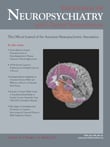To the Editor: Parkinson’s disease is a degenerative disorder of the CNS, the main symptoms of which are a vast range of movement disorders like tremor and rigidity. The symptoms are the result of insufficient formation and release of dopamine in substantia nigra.
1 The main treatments of Parkinson’s disease are drugs and deep brain stimulation (DBS). Many drugs such as l -dopa and l -deprenyl ameliorate the disease; however, the effects of these drugs would decrease as the disease progresses.
Deep brain stimulation is an invasive treatment involving the implantation of a brain pacemaker, which sends electrical impulses to specific parts of the brain. Deep brain stimulation has provided remarkable therapeutic benefits for otherwise treatment-resistant movement disorders such as Parkinson’s disease
1 ; DBS directly changes brain activity in a controlled manner, and its effects are reversible. Deep brain stimulation does not cure Parkinson’s disease, but it can help manage some of its symptoms and subsequently improve the patient’s quality of life.
1 The underlying principles and mechanisms of DBS are still not clear. We discuss below some of the existing hypotheses in this regard.
Assuming that parkinsonian tremor is associated with abnormal oscillations in some regions of the brain, high frequency stimulation might act simply to block or interfere with the transmission of oscillatory activity to the motor neurons.
2 This hypothesis is imprecise. Why can an external signal block the internal oscillations? Why are they not added to strengthen the symptoms?
Another hypothesis is that high-frequency stimulation acts via reversible inhibition of the target function, thus mimicking the effects of destructing the target structure.
3 This hypothesis is in doubt because it has fewer side effects than the destruction treatments.
High-frequency DBS might act to entrain the abnormal oscillator in a 1:0 rhythm so that the oscillator is effectively arrested as the consequence of repetitive phase resetting. This is similar to what happens in simple models of cardiac oscillators.
4 Because of high complexity of signals in basal ganglia, a simple mechanism using an external signal may not be able to do this. Moreover, since the brain has a variable dynamic, a steady signal cannot play the suggested role.
Deep brain stimulation might lead to a change in system parameters, and this in turn would lead to a Hopf bifurcation in the dynamics so that the abnormal limit cycle associated with the tremor would be destabilized. This change in system parameters may be related to a gradual change in network properties generating the tremor.
5 Under the Hopf bifurcation hypothesis, the periodic oscillations associated with the tremor would no longer be present in any of the brain structures. This hypothesis may be more valid because of having a dynamic view on the brain and neuromuscular system. However, considering brain as a simple Hopf bifurcation system may not be true, because the brain can show different responses in different states. This hypothesis cannot satisfy rest tremor of Parkinson’s disease because according to this hypothesis, patient is in oscillatory state of Hopf bifurcation system. Therefore, the oscillations may not be removed whenever the patient has voluntary movements. In addition, the relation between parameters of Hopf bifurcation system and DBS is not clear.
Our hypothesis includes assessing the system in a global view. Regional recordings of specific points of brain and muscles suggest that the signals obtained from a healthy person have a chaotic nature. In pathological condition, the system’s chaotic nature is lowered.
6 Some systems can model chaotic and nonchaotic behavior simultaneously. One of the simple systems that can model this behavior should have three independent frequencies, and each pair of them is irrational. In this condition, we see a chaotic behavior from the system, but if one of the frequencies lacks the irrationality to other frequencies, the response can be quasi-periodic or limit cycle signal. Therefore, we can suppose that the three independent frequencies that are irrational in pairs exist in the brain structure that will result in a chaotic response in the healthy person. In the disease state, because of impairment of the nerve cells in some parts of the brain, we may lose the irrationality of one of the frequencies to other ones that lead to the symptoms of the disease. If we bring the system to the earlier state using a third external frequency that is irrational to the others, we may ameliorate the disease symptoms. Therefore, we propose that the DBS is the third signal that has a frequency that is irrational to the others. The different effectiveness of DBS on different persons may be understood in the light of this viewpoint.
Some of our primary unpublished studies show that a simple system named “sin Circle Map” can simulate the behavior of Parkinsonian tremor and effect of DBS on suppressing it.
7We believe that the proposed model can be a good simulation for presenting the healthy and disease states of brain behavior and the effect of DBS on the Parkinson’s disease. Using this novel viewpoint may lead to better analysis of DBS and its utilization in similar disease states.

